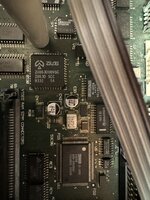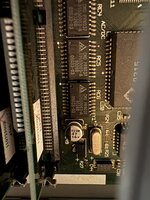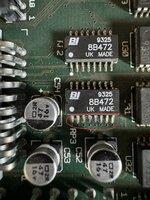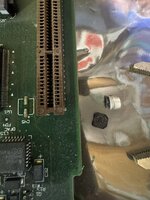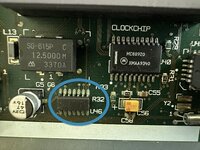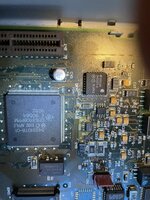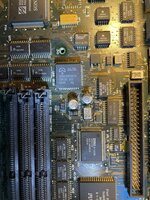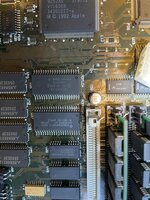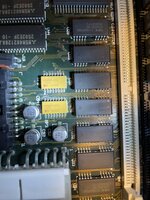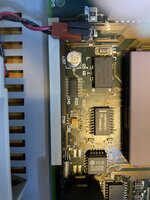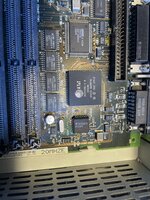Well, I did a virtual dumpster dive today. I was out for a walk. It was trash collection day on the block. There was a Centris 610 just lying out on the curb for collection. It looked like it had been exposed to a lot of soot or some other black dust, but was only missing the cosmetic panel for the CD-ROM. I checked it out as discreetly as possible.. no rust on the video/SCSI connectors.. no shattered cover.. I am trying to finish off my Mac restoration habit, but this was too tempting. I went back and got it.
Once home, I opened it. Hmm, it was fully stocked, odd. Looked like it had not been pillaged at all. I broke it down, and brushed and air-dusted away the black stuff and dust balls. All dry cleaning. No solvents, yet. The logic board looked only borderline salvageable. Photos attached.
Every single 47uF can-cap has leaked, and the nearby chips have been affected. Note in particular the ROM leads, the IOSB small-numbers leads, the Zilog too. My rework skills are certainly not up to lifting the IOSB or the 8530 and putting them back down.
killvore - I've got damage like you have on U46, too (see IMG_5240) .
There was just a hint of white ghosting around the clock battery mount, no orange rot, so perhaps the nearest cap was to blame for that. The old battery looked fine, but had no measureable voltage remaining.
But voila, it boots. Someone dumped a bootable Mac. 68LC040 at 20MHz. 12MB RAM total. Two empty VRAM SIMM slots. Internal audio plays the happy chord. Video works. But, the internal HDD (230MB) has issues. So that's why it was being trashed.
Tested the internal SCSI with a known good HDD. Haven't tested the serial ports, sound in, CDROM, or Ethernet yet
I will most certainly recap. Ten 47uF tantalums are cheap. I have already replaced the clock/PRAM battery. I will overhaul the FDD, as it is very slow in ejecting discs, and it is always good to clean the heads on a dusty FDD. I'm now eager to find an FPU expansion, a CD caddy, and an AAUI-to-10BaseT solution. VRAM SIMMs are still available. I'll search for any 3d-printable CDROM faceplates, too. The black dust mostly came off of the cover, and the cover clips are broken but still get a grip. Perhaps some clear epoxy will adhere to the cover clips.. I doubt cyanoacrylate (super glue) will.
Not sure I should go overboard in cleaning up the corrosion. But U46 and the resistor packs, maybe.


